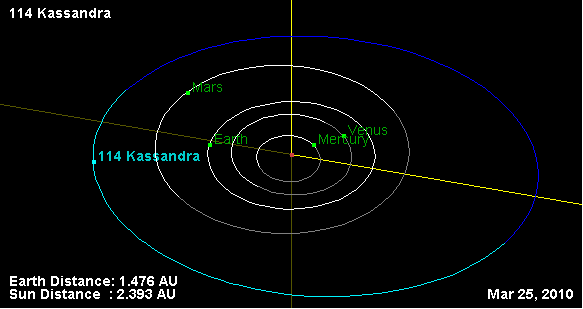Discovery date 23 July 1871 Observation arc 113.62 yr (41501 d) Discovered 23 July 1871 Discovery site Litchfield Observatory | Minor planet category Main belt Aphelion 3.0407 AU (454.88 Gm) Orbits Sun | |
 | ||
Perihelion 2.31581 AU (346.440 Gm) Discoverer Christian Heinrich Friedrich Peters Similar 167 Urda, 80 Sappho, 188 Menippe, 165 Loreley, 196 Philomela | ||
114 Kassandra is a large and dark main-belt asteroid. It belongs to the rare class T. It was discovered by C. H. F. Peters on July 23, 1871, and is named after Cassandra, the prophetess in the tales of the Trojan War. The asteroid is featured in the 2009 film Meteor, in which it is split in two by a comet, and set on a collision course with Earth.
This object is classified as a rare T-type asteroid, with parts of the spectrum displaying properties similar to the mineral troilite and to carbonaceous chondrite. The shape of the spectrum also appears similar to fine grain from the Ornans meteorite, which landed in France in 1868. The light curve for this asteroid displays a period of 10.758 ± 0.004 hours with a brightness variation of 0.25 ± 0.01 in magnitude.
During 2001, 114 Kassandra was observed by radar from the Arecibo Observatory. The return signal matched an effective diameter of 100 ± 14 km. This is consistent with the asteroid dimensions computed through other means.
In the plot of 2009 disaster film Meteor (TV miniseries) 114 Kassandra was deflected by a collision with a comet, putting it on a collision course with earth.
